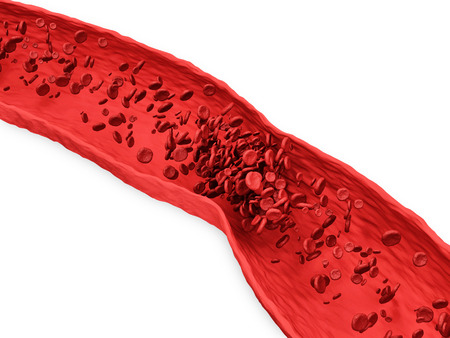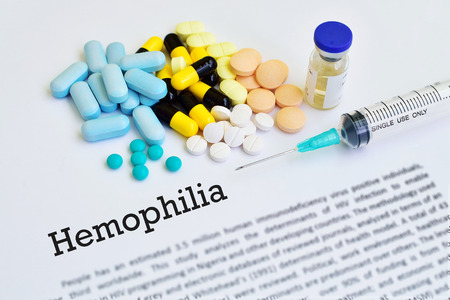Hemophilia – The Blood Clot Disorder
Hemophilia is an inherited genetic blood clotting disorder where the ability of the body to form blood clots is deranged. This leads to excessive bleeding as the blood does not clot effectively.
What Causes Blood Clots?
In normal conditions, after an injury, platelets (that are formed within the bone marrow) aggregate at the puncture site and form a plug. Along with this there is another action is the body and that is by clotting proteins or clotting factors. There are 13 clotting factors in the body and even if one of them is absent, then the clotting mechanism is disturbed. This bleeding disorder could be manifested in the form of mild, moderate or severe clotting problems.

Types of Hemophilia
There are three identified types of hemophilia depending on the clotting factor affected.
Hemophilia A: Factor viii hemophilia is the commonest type of hemophilia. It occurs due to the deficiency of factor VIII.
Hemophilia B: Hemophilia b is caused by the deficiency of factor IX. The other name for it is christmas disease.
Hemophilia C: This is the mildest form of hemophilia and it occurs due to the deficiency of factor XI. This is a rare disease and the patient does not have spontaneous bleeding. The diagnosis becomes evident only after an injury, post surgery or trauma.
What Causes Hemophilia?
When an injury takes place, the earliest reaction is formation of a platelet plug (earliest signs of blood clot). Along with this, clotting factors are activated which lead to stoppage of the bleeding by forming a stronger clot. In hemophilia causes, the clotting factors VIII, IX and XI are absent and so the cascade is broken and the bleeding doesn’t stop like it should. This is primarily because of a defect in the gene that is responsible for formation of the clotting factors. This gene is located on the X- chromosome. Hemophilia is an X linked recessive genetic disorder and it runs in families.
Males have one X and one Y chromosome. So if a male inherits the defective X chromosome from his mother, he can get hemophilia. In females, if one X chromosome has the defective gene, the other normal X chromosome will prevent the disease from actively coming up. Such a female will become a “carrier” of the disease and will pass on the disease to her children.
A male with a faulty gene on his X chromosome can pass on the disease to his daughter but not to his son. This is because the daughter inherits an X chromosome. A female must have defective genes on both her X chromosomes to get hemophilia which is rare.
This is the reason why hemophilia A and B are more common in males than in females. Hemophilia C on the other hand is an autosomal inherited genetic disease that is not linked to the sex chromosomes (X and Y) and so it is seen in both males and females equally.
Symptoms of Hemophilia
The inability of the body to form clots can lead to spontaneous bleeding as well as bleeding within the internal organs of the body. The extent of the symptoms will depend on the deficiency of factors. If the deficiency is very severe, then there can be bleeding without any cause. The hemophilia symptoms are:
- Bleeding in the urine
- Bleeding in the stool
- Bruising on the skin
- Large bruises on the body without any history of injury
- Bleeding gums
- Nosebleeds
- Bleeding within the joints can lead to joint damage and also disfigurement.
- Bleeding in muscles and soft tissues of the body.
- Irritability in small children
- Severe bleeding after a dental procedure, accident or surgery.
- Mild bleeding symptoms in females due to the presence of one normal X chromosome.
Complications of hemophilia can be because of the disease or as a result of its treatment. They are:
- Joint damage due to haemarthrosis.
- Deep muscle bleeding
- Infections contracted as a result of frequent blood transfusions that are a part of the treatment of hemophilia
- Reactions to clotting factor treatment that is administered.
- Intracranial hemorrhage
- Hemophilic arthropathy
Diagnosis of Hemophilia
Hemophilia can be diagnosed during pregnancy and after the birth of the child. This is most essential when there is a positive family history of the disease. Mild forms of hemophilia come to light only after a surgery or dental procedure when the bleeding fails to stop.
- Before conceiving, couples who are aware of the presence of hemophilia, should opt for genetic counseling and testing. This helps to determine the probability of passing on the disease to the child. The test is usually a blood test and it is examined for signs of abnormal genes that cause hemophilia.
- If a lady with hemophilia gets pregnant, then extensive testing needs to be done during the pregnancy. These tests are CVS- chorionic villus sampling which is done between 11 to 14 weeks of pregnancy by testing a small sample of the placenta. Another test which is routinely done in such cases is amniocentesis where in a sample of the amniotic fluid is taken and tested. This test is done around 15 weeks of pregnancy. A needle in inserted under ultrasound guidance and the fluid is collected and analyzed. During pregnancy, these procedures are associated with a risk of miscarriage and preterm labor. So they must be discussed in detail with your doctor.
- When there is a positive family history, the umbilical blood of the baby is collected immediately after birth and sent for testing. This can help determine whether the child has hemophilia A or B.
- Blood tests that are used to assess bleeding disorders are
- Bleeding time
- Platelet count
- Clotting time
- Prothrombin time (PT)
- Activated platelet Prothrombin Time(APTT)
Treatment of Hemophilia
Hemophilia treatment with clotting factors is mainly indicated in severe cases. Mild cases of hemophilia need no treatment.
Hemophilia A is treated with the help of a prescription hormone called desmopressin which is injected directly into the vein. This medicine has an action on the factors that cause blood clotting.
Hemophilia B can be treated by infusion with donor clotting factors. If synthetic clotting factors are used, they are called as recombinant clotting factors.
Hemophilia C is treated with the help of a plasma infusion that helps to stop bleeding.
If there is a history of bleeding within the joint causing joint damage and deformity, the physical therapy and rehabilitation will be of much benefit. Pain medications and steroids may also be given depending on the symptoms of the patient.

Contraindications in Hemophilia Patients
- Anticoagulant medications like warfarin and heparin are strictly contraindicated in people with hemophilia as they can increase the clotting difficulties and lead to more bleeding. Drugs that have a blood thinning effect like aspirin, ibuprofen etc are also contraindicated in hemophilic patients.
- Sports with high intensity or having a likelihood of injury like skateboarding, boxing, wrestling etc should be avoided strictly.
Prevention of Hemophilia
Hemophilia is a genetic disorder and is passed on from the parent to the child. There is no way to check whether the baby will get the disease or not. However pre natal genetic counseling is a must so that the parents are aware of the risk ratio and be prepared before they decide to go ahead with the pregnancy. If a lady is a carrier of the disease, testing should be done for the partner before they get married so that the disease can be avoided in the next generation.
